| Retour
Independence day 4 july 1943 The B-17 flying fortresses shot down in our region and the fate of their aircrews. | In
the course of two years spent researching the events that took place on
this sunny summer day of July 4, 1943, "Independence Day" in the USA,
the information gathered came from four different sources: the most
productive came from contacts with the persons involved: first the
surviving airmen themselves, second the US Archives at Maxwell Air
Force Base in Alabama, then reference documents or general information,
and finally various personal contributions from researchers specialized
in studies of air combat. The presentation of this article has been
voluntarily simplified in order to keep the essential elements tied to
these evasions . . . the long and dogged odyseey of men bent to escape
capture at any cost, with the help of compassionate souls, either
volunteers or members of various patriotic networks. A human adventure
with only one goal: returning to Great Britain, the only free land in
occupied Europe. One should recall first that, in every case, the
tragic events that took place in the life of their inhabitants and
their painful consequences have been related on various occasions by
the local press. In the present case, the main purpose was to relate
the unknown part of this adventure, that is the long and difficult
journey back to their base or their country for the airmen who had
survived this "Independence Day". On
that day, July 4, 1943, as the formation of B-17 flying fortresses was
on its way to their target, several dramas were taking place in the
skies of the Orne and Sarthe departments, virtually at the same moment. 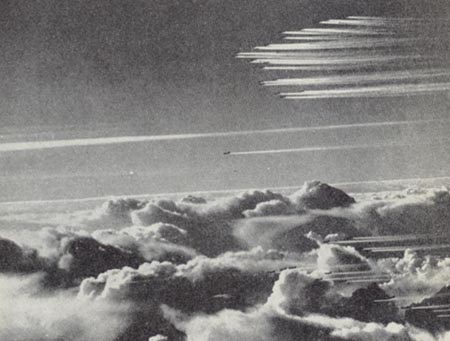 Let us resume the facts:
One hundred sixty B-17 flying fortresses from bases in the South East
of England are dispatched on this Independence Day towards targets
defined by the US Air Force headquarters. Among them one hundred are
heading towards the Gnome and Rhone factories which manufacture engines
for the German Fockewulf planes. The sixty others have for targert the
flood-gates of La Pallice. Several other nearby installations are also
targeted, including the train station in Le Mans and the adjoining
airdrome. One this Summer day - a Sunday - the townsfolk who witnessed
this drama remember that the sky was blue and clear during the flight
of the US Air force formation, and yet the Thunderbolts and Spitfires
accompanying the fortresses would be prematurely recalled by their base
because of deteriorating meteorology conditions in Great Britain.
Certainly a handicap for the heavy bombers deprived of assistance. . .
in case of a confrontation with the German fighters always on the
lookout. According to the American archives now available, the first
part of the raid went without any noteworthy incidents and the pilots
stated that they had reached their respective targets.
| 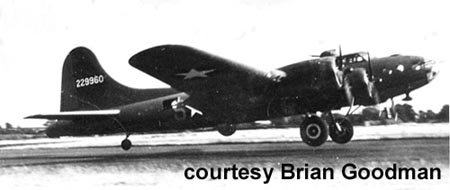 | B-17F 42-29960 "Nymokymi" in June 1943. | 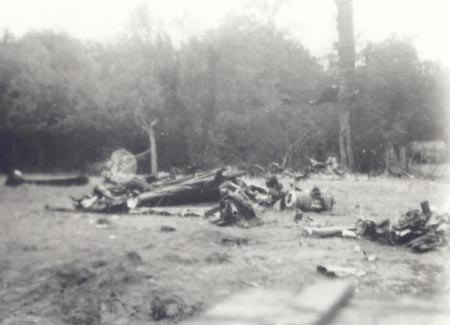 | The
wreck of "Nymokymi" in Belfonds. These are the only existing photos of
the wreckage taken by Roger Cornevin, July 5 in the morning. | | Near
Le Mans German flak targets and hits a first fortress. In the distance
a swarm of German fighters are getting ready to attack. . .
The
right outside engine of the fortress "Nymokimi" of Lieutenant Gordon
Erikson has just been hit broadside by flak and the propeller is
feathered. The plane is distress, trailing a long wake of black smoke,
reaches the small episcopal town of Sees as the formation is flying
back to England.
It is noon. The parishioners are walking out of
the cathedral. The Ormeaux Stadium field, usually occupied by the
Werhmacht, is vacant today for the local and regional athletic teams.
Everyone is watching the fortress desperately trying to reach Grafton
Underwood, North of Bedford, the most Western base in East Anglia she
had left from two hours earliers, but it is no longer possible. . . The
pilot Gordon Erickson stated later: "with one engine
disabled, we were trailing behind the formation heading North. The
German fighters, on the lookout, rush towards our now disabled and
isolated aircraft. The oxygen circuits which allows us to fly at more
than ten thousand feet are destroyed by a murderous enemy fire. I give
order to bail out. On board the fire is raging and the crew rush to the
emergency exits. We have great difficullties opening the evacuation
traps. . . My overalls catch fire and I try to put it out with my
hands. As a last resource I go to the emergency exit to
the front, and I jump out behind the mechanic. The icy cold air blowing
through the ejection trap finally put out the flames which were slowly
burning my overalls. Below me I see five white corollas. . ., green
pastures. . ., a river and a cathedral in the distance. I land, unhurt,
on this foreign soil, my parachute caught in the branches of an apple
tree. . ., my feet barely touching ground. Some villagers run toward me
to help. . ., I remove my equipment: parachute and Mae West. Quickly I
use my pocket knife to cutt off the straps of my parachute. I take
cover in a double row of hedges and soon three other members of my
crew, burned on their hands and face, join me here". In fact
eight airmen had parachuted on the Belfonds plain in an area between
the hamlet of Conde le Butor and the church of Cleray. Two airmen had
stayed aboard: bombardier Donald Irvine fell with what was left of the
machine-gun turret at a site called "Chene d'amour" (oak of love) near
Belfonds, and navigator Francis Hackley, his parachute in flames, fell
at "Val d'enfer" (vale of hell).
Two crewmembers did not escape
capture in spite of the quick intervention of the townsfolks and
members of the local resistance, among which were Edouard Paysant,
Departmental Chief of the BOA and Victor Chevreuil, Mayor of Mortree.
The six survivors, comrades of misfortune, will split into two groups;
Lt pilot Gordon Erickson and three crewmembers will be sheltered in a
barn near the village of Belfonds. The two wounded men, Willard Freeman
and Charles Mankowick will be taken on stretchers by the local
Resistance first to a shelter and then to the Forest of Gouffern near
Aunou le Faucon. A hut made of branches, hidden deep into the forest,
will be their shelter for three weeks during which they receive the
necessary care. "our hut was not very watertight but it was sufficient
to shelter us in August. Two doctors came by regularly to check on the
progress of our recovery" Freeman stated later.
Six months later,
after spending a few nights under the stars, followed by a long stay in
the Lyon region to regain some strength, our two convalescents will
reach England and their respective base in December 1943. Gordon
Erickson, accompanied by Sargeants Ashworth, Penly, and Wingerter, will
attain Gilbraltar at the end of August 1943 after an eventful journey,
crossing Basque country without any major problem except for a scary
moment in Dax caused by the inquisitive look of a German agent puzzled
by the shoes our travelers are wearing. Alarming suspicion which
worries our evadees and make them fear the worse. Will their false
identity papers stand up to close scrutiny?
After a long dialogue with the agent, their experienced guide finally get them out of this delicate situation.
At last our evadees cross the border in a truck carrying. . . baby
chicks. Soon after, they reach Bilbao and finally freedom at the
British Consulate here. After the crossing of the Pyrenees and their
arrival to Gibraltar where they are taken in charge by the RAF, our two
wounded men, Freeman and Mankowick, now fully recovered, announce their
safe arrival as soon as they reach London by transmitting the following
message on the BBC: "the friends of the little forest have arrived
safely". What a relief for all the resistants and their helpers in the
Sees, Montree and Argentan region, who had worked to ensure their
evasion, at the risk of their own lives.
Other infos on this crash: http://www.384thbombgroup.com/pages/erickson.html | | 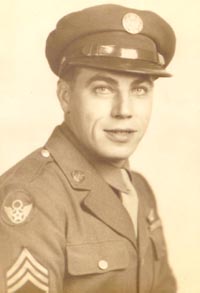
Willard Freeman | 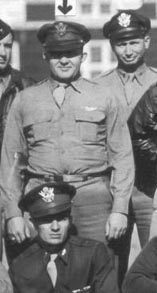
Gordon Erickson | | (Collection Didier Cornevin) | (Collection Didier Cornevin) | 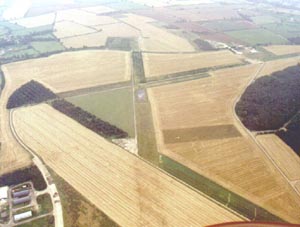 | | Grafton Underwood, Airfield of the 384 BomberGroups, today. |
| On
the same day and at the same hour, the village of La Coulonche North of
Juvigny-sous-Andaine witnesses a similar drama. The flying fortress
flown by Lieutenants Olaf Ballinger and John Carah suffers the same
fate, crashing at "Val de Vee" in the Andaine Forest. John Carah: "I
had not realized that we did not have any more oxygen and that the two
tail gunners had been killed during the attack by the German fighters.
The elevator jammed and it was impossible to pilot the plane. I jumped
out, remembering the massacre in Antwerp when the parachutists had been
taken for targets by the German fighters. At the emergency door was
Llieutenant Williams, his unfolded parachute in his arms. . . I told
him to jump no matter what. . . but he refused. Huge emotion! While
coming down, a fighter feigning an attack swooped down on me and scared
me to death. . . Then I saw our flying fortress get into a spin while I
desperately scrutinized the ground below to finally spot an apple
orchard. I barely managed to avoid the fork of a tree. I remained in
hiding in the woods for seven hours while observing the surroundings
and the comings and goings at a farm before taking the risk of showing
myself to the farmer. A carafe containing a clear liquid caught my
attention. . . Thirsty, I gulped a glass of calvados. . . I had
mistaken for water.".
The crew had lost three of
its members: the two tail gunners killed in flight and Lt Williams who,
desperate, decided to jump. . . too close to the ground. Why did he
wait so long? Remembering having seen him jump out of the front hatch
at the last minute before the explosion on the ground, John Carah to
this day still wonder why. . ..
Two crew members were taken
prisoners then taken to "Stalag Luft" reserved for Allied airmen. Taken
in charge by a young guide and with the help of an organized Resistance
network, John Carah will leave for Switzerland after having been
sheltered near Lassay, in the Mayenne region, by the Breteau family.
Provided with a fake identity card in the name of. . . Jacques Dupont,
business representative, he and his companions take any means of
transport available on the way. . . train, bus, Petain Youth's camp
truck, hitch-hiking. Finally it is a trek on foot through the pine
forests, pursued by patrol dogs guarding the border. Our little group,
treating themselves to the luxury of a sympathetic taxi driver will
attain Berne incognito via the verdant shore of the Lake of Neuchatel.
The stay of John Carah in Switzerland, in relative freedom, could not
last very long. He takes the risk to leave Swiss neutrality and
attempss, once again, to cross the border. . . to occupied France. . .
Incarcerated with his travelling companions by the Gestapo, they are
freed, without having to put up a fight, by the local Resistance after
a brisk exchange of fire. John reaches Spain totally exhausted after
the difficult crossing of the Pyrenees. At last, he perceives from afar
the lights of Figueras!
We bring the attention to a final thought
in the testimony of this pilot aided by volunteers helpers and
Resistance members: "I take this opportunity to express my
utmost admiration and gratitude to the various French Resistance lines.
Every hour of the day they risk their lives so that a great numbers of
shot down airmen could return to combat and thus perhaps shorten the
length of the war".
Another epic tied to this
crash in La Coulonche is the one of pilot Olaf Ballinger. Exhausted and
lagging behind, he is unable to follow the same pace as his travelling
companions. Thus he will barely escape their fate when they are caught
in an ambush. In the pale dawn lighting the foothills of the Pyrenees,
exhausted and his clothes in tatters, he reaches the first houses of
the Andorre region. Sustained by the will to reach his goal at any
cost, he takes a needed rest in a village which seems uninvolved in the
torments of war. He will face the first cols in the wake of a group of
smugglers carrying bales of tobacco. Then after a temporary captivity
in a jail in Manressa, he reaches the British Consulate and finally
Gibraltar on December 4, exactly five months after the crash in La
Coulonche. | | 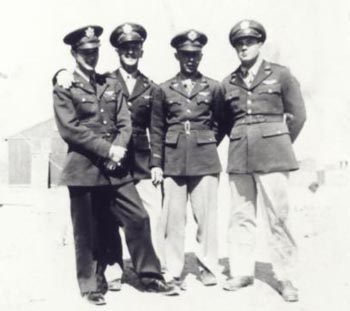
| | left
to right: McConnell, navigator; Bollinger, pilot; Williams, parachute
opened in the plane; John Carah, copilot. | | Credited
with having shot down one enemy fighter, Paul McConnell is helped by a
forester in the Andaine Forest. He spends a few days in hiding at the
"Ermitage", a manor situated North of Juvigny -sous-Andaine and then he
is taken in charge by Andre Rougeyron. It is at this time that he is
reunited - unexpectedly - with another crash survivor, William Howell.
Young machine gunner Howell, hastily dressed as a boy-scout, sporting a
Basque beret and carrying a basketful of vegetables for the sake of the
cause, arrived at the "Chalet du Brouillard" (Andre Rougeyron's home in
Domfront) in a horse drawn carriage. With the help of some Calvados, he
endures without complaints the extraction of schrapnells from his back.
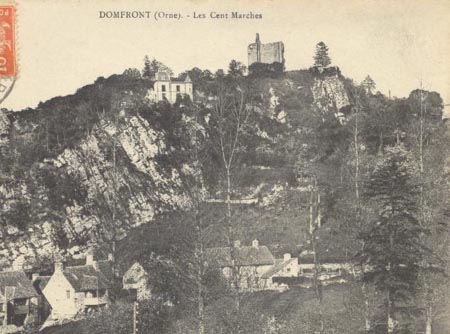 | | "The chalet of fog" in top where many aviators was hidden by André Rougeyron in the public garden of Domfront. | An
opportunity will come up for Paul McConnell and William Howell to try
an escape with the Brittany line. But the plan organized in Quimper by
the local Resistance, in coordination with a speed motorboat and a
British submarine off the coast of Ouessant will not succeed. The radio
operator in charge of communications with England had been identified
and killed. However, they will have to make the best of it and return
to Paris to wait for a second opportunity. Reluctantly Paul McConnell
and William will part company. Howell will go on to Perpignan where he
is taken in charge by some unscrupulous guides who will make him and
his evadee companions go round in circles near the border. After the
Christmas holiday it is at last the successful crossing of the
Pyrenees, then on to Gerona, Barcelone, Madrid, and finally Gibraltar
in February 1944, seven months from the date of the crash in La
Coulonche.
In desperation, the Resistance decides to turn over the
navigator Paul McConnell* to the "Comete" line an organization where,
for each escape, one courageous patriot would pay with his life. Train
to Pau, a stop at a Basque farmhouse, frequent change of guides, a long
march without respite in the bitter cold before reaching, exhausted, a
Spanish farm. Then a stay in a jail where some thirty prisoners evadees
- crash survivors and German deserters - are awaiting for the Spanish
authorities to decide of their fate. At last it is the much awaited
welcome of the United States Embassy, then Gibraltar, and finally one
last stop,Scotland, and the return to the United States on March 1,
1944, that is an eight month journey since the crash in La Coulonche.
| 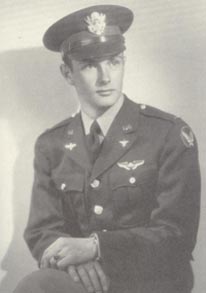 | 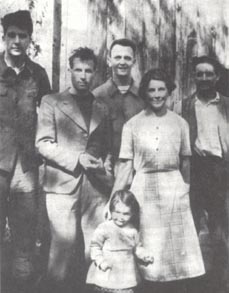 | 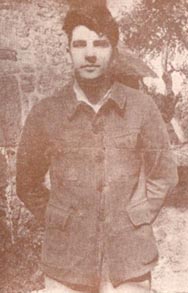
| | McConnell, navigator | Owens, Bollinger (center) and the family who hid them. | Owens, Gunner. | | Machine-gunner
Owens, another miraculous survivor of the crash at Val-de-Vee, would
not escape destiny. After being sheltered by Geslain, a farmer in St
Opportune, he accompanies Ballinger and his group part of the way on
their journey. His body will be found in the mountains and the cause of
his death will remain a mystery. There are various explanations . . .
he was killed by a border while crossing the foothills of the Pyrenees
or he died from exposure to the elements.
| 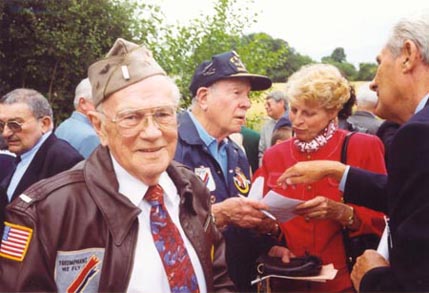
| 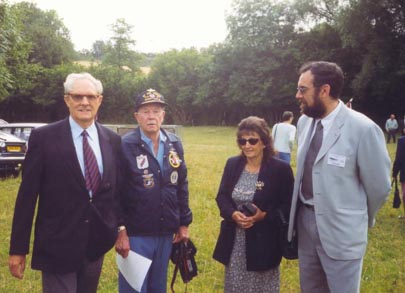 | | Paul
McConnell, in leather jacket and John Carah, with the blue cap, at the
time of the ceremony of Belfonds in 1999 | |
| During
this same raid, at the same hour, two other flying fortresses were shot
down in the Sarthe region, West of Le Mans. Machine-gunner David
Butcher will be the only surviving crew member. His fortress "Lakanuki"
is hit by flak and explodes in flight. Panic. . . surviving instinct. .
. almost unconscious, he finds himself, miraculously, parachute opened,
above the village of Poille sur Vegre. "What a bizarre feeling!" he
will say later. Two providential villagers help him slip away. . . by
bicycle. Clandestinely employed as a "deaf and mute" gardener and later
on unwillingly draftet in the local Resistance network, he takes part
in receiving the arms parachuted by planes supplying the maquis. His
adventurous journey in French territory willl have lasted seven months.
His companions in the Resistance will have suffered various fortunes
but David Butcher, lucky in spite of himself, thwarted all the ambushes
set on the way. He kept undying memories of his stay on French
territory . Today he is honorary citizen of Poille sur Vegre.
| | 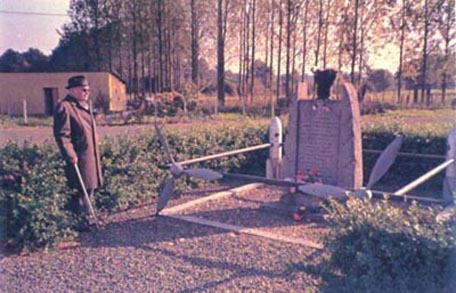
| 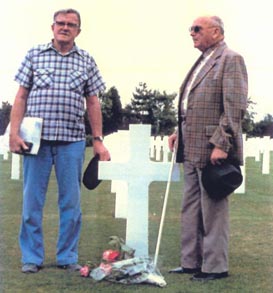
| | Alfred Auduc, chief of the local Resistance and belonging to the "reseau Buckmaster" . | David
Butcher, alone survivor of the crash of the Fortress "Lakanuki" and
Alfred Auduc. |
| Noon
and the twelve strikes of the town clock chime in the quiet countryside
of Noyen Malicorne Maezeray area. The inhabitants go about their work.
A fourth fortress, the "Mugger", hit by flak, crashes. A witness
notices in the distance "the parachutists coming down and trying to
avoid the areas in flames on the ground". The fire spreads. All are
fighting the blaze: the Werhmacht, the gendarmes, the firemen, and the
townsfolk. . . One
of the airmen lands on the roof of a hangar, another near a German
encampment. The latter will relate: "I had landed in a wheatfield just
harvested. No way to hide. I noticed a wooded area nearby. I heard
gunfire and saw two German soldiers running toward me gun in hand. I
had suffered serious burns on my hands and face. . . and I was
bleeding". Among the ten crew members: two killed, two taken prisoners,
and six evadees who will manage to slip through the net spread by their
pursuers. But once again it is a tragedy heavy with consequences for
the townsfolks among which some, as it happened in our little town of
Sees . will know deportation.
|
| Leaving
this very day the airfields of East Anglia sixty other B-17 flying
fortresses are flying in direction of the locks of La Pallice. Four
other fortresses will be shot down by flak and German fighters at the
following points: Island of Oleron (Charente Maritime), La Gueriniere
(Vendee), St Colomban (Loire Atlantique) - The following link tells the history of this fortress:https://b17-saint-colomban.ovh - and the Bay of Biscay. A ninth fortress will make a forced emergency landing upon her return to Great Britain.
Before
rejoining their respective bases in Great Britain, the airmen who have
survived the crash of their plane in our region on this Independence
Day have endured, as many others have, the dangers of aerial combat,
the resulting terrible emotion and lastly. . . the jump into the
unknown on a territory full of traps and pitfalls after having bailed
out of their disabled aircraft. All these dramatic events are generally
followed by an uninterrupted manhunt in the woods, the towns, or the
countryside.
It
is often possible to bring together a view of the facts and events, if
one consider the dangers incurred, with the testimonies from the
Resistance members and all the others - patriots, those who gave
shelter, the anonymous volunteer helpers - met by chance in a forest
and having participated in the rescue and life-saving operations at
their own risks and perils. Roger Cornevin, Association Normande du Souvenir Aérien 39-45 Translation by Marie Antoinette McConnell | | 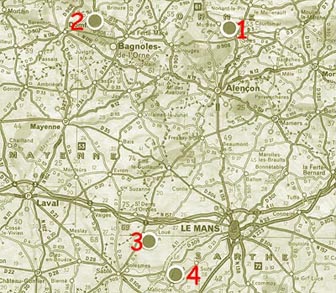
| | Localization
of the crashs: 1 Belfonds; 2 la
Coulonche; 3 Poillé sur Végre; 4 Malicorne | | 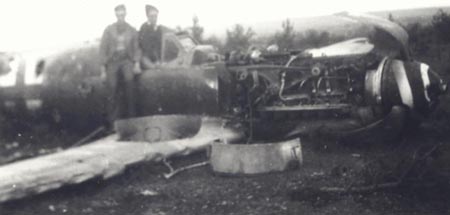
| | Roger Cornevin and his brother on the wreckage of a Me 109 shoot by Flying Fortresses, July 4 1943. | | *
After the failed escape attempt off the Brittany coast, Paul McConnell
returned to Paris where he was sheltered by Resistance members -
Raymonde Chassagne in Paris and Lucienne Fevre in Pavillons-sous-Bois
(shortly after Paul McConnell's escape , Raymonde Chassagne was
arrested by the Gestapo and sent to the concentration camp of
Ravensbruck). On December 24, 1943, another escape attempt was aborted
when the line had been infiltrated and most members arrested.
Sources:
Personal letters with the allied aviators, Archives of the Usaaf,
"Agents d'évasion" of André Rougeyron. Cahiers flêchois 1995. | Thank you to ask for the author's authorization for a partial or complete publication of this narration | | Retour |